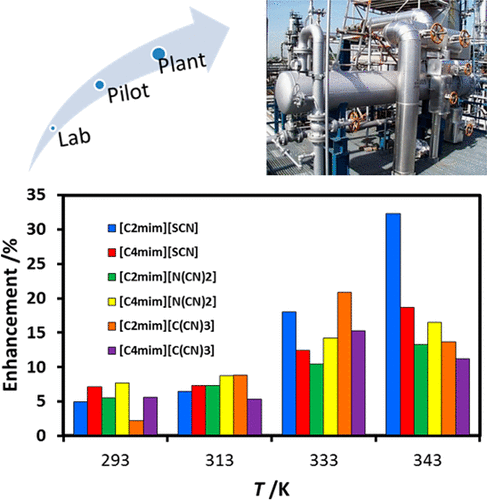当前位置:
X-MOL 学术
›
Ind. Eng. Chem. Res.
›
论文详情
Our official English website, www.x-mol.net, welcomes your
feedback! (Note: you will need to create a separate account there.)
Thermal Conductivity of Ionic Liquids and IoNanofluids and Their Feasibility as Heat Transfer Fluids
Industrial & Engineering Chemistry Research ( IF 3.8 ) Pub Date : 2018-04-23 , DOI: 10.1021/acs.iecr.7b04770 João M. P. França 1, 2 , Maria José V. Lourenço 1 , S. M. Sohel Murshed 1 , Agílio A. H. Pádua 2 , Carlos A. Nieto de Castro 1
Industrial & Engineering Chemistry Research ( IF 3.8 ) Pub Date : 2018-04-23 , DOI: 10.1021/acs.iecr.7b04770 João M. P. França 1, 2 , Maria José V. Lourenço 1 , S. M. Sohel Murshed 1 , Agílio A. H. Pádua 2 , Carlos A. Nieto de Castro 1
Affiliation

|
Ionic liquids and ionanofluids were studied in recent years as possible alternatives to current engineering fluids, namely in the area of heat transfer. Excellent thermal properties, like high heat capacity per unit volume and thermal conductivity, allied to the dispersion of nanoparticles in them, have created great expectations, as the enhancement of their thermophysical properties liquids can contribute to better efficiency in heat transfer. The thermal conductivity of [P66614][N(CN)2], [P66614][Br], [C2mim][SCN], [C4mim][SCN], [C2mim][C(CN)3], and [C4mim][C(CN)3] in the temperature range of 293–343 K at 0.1 MPa and their ionanofluids with multiwalled carbon nanotubes are reported in the present work. While we could not obtain stable suspensions with phosphonium based ionic liquids, thermal conductivity enhancement of cyano-based ionic liquids was compared with our previous work using dicyanamide ionic liquids. The thermal conductivity of C2mim+ ionic liquids and ionanofluids is generally higher than the corresponding C4mim+ fluids. Temperature dependence of thermal conductivity enhancement hinders the conception of a unified thermal conductivity enhancement predictive model of the presented ionanofluids, current theories under-predicting its value for the dispersions studied. Finally, we selected a specific heat transfer process and calculated the heat transfer area necessary using currently commercialized heat transfer fluids, ionic liquids, and ionanofluids. While the addition of nanomaterial to the ionic liquids leads to an increase in the heat transfer available area, the enhancement of the thermophysical properties leads to a smaller variation of the area with temperature. Depending on the ionic liquid, some of the ionanofluids studied are head-to-head with a significant number of currently used heat transfer fluids concerning the heat transfer area necessary to transfer the same amount of heat.
中文翻译:

离子液体和离子纳米流体的热导率及其作为传热流体的可行性
近年来,已对离子液体和离子流体进行了研究,以作为当前工程流体的可能替代品,即在传热领域。优异的热性能,如每单位体积的高热容和热导率,与纳米颗粒在其中的分散性相关,已引起人们很高的期望,因为增强液体的热物理性能可以提高热传递效率。[P 66614 ] [N(CN)2 ],[P 66614 ] [Br],[C 2 mim] [SCN],[C 4 mim] [SCN],[C 2 mim] [C( CN)3 ]和[C 4 mim] [C(CN)3]在293–343 K的温度范围内(0.1 MPa),以及它们与多壁碳纳米管的离子流体在本研究中得到了报道。虽然我们无法使用phospho类离子液体获得稳定的悬浮液,但将氰基类离子液体的导热性提高与我们先前使用双氰胺类离子液体的工作进行了比较。C 2 mim +离子液体和离子液体的热导率通常高于相应的C 4 mim +液体。热导率增强的温度依赖性阻碍了所提出的离子流体的统一的热导率增强预测模型的概念,目前的理论不足以预测其对所研究分散体的价值。最后,我们选择了一个特定的传热过程,并使用当前商业化的传热流体,离子液体和离子流体来计算必要的传热面积。虽然将纳米材料添加到离子液体中导致热传递可用面积的增加,但是热物理性质的增强导致面积随温度的变化较小。取决于离子液体,
更新日期:2018-04-23
中文翻译:

离子液体和离子纳米流体的热导率及其作为传热流体的可行性
近年来,已对离子液体和离子流体进行了研究,以作为当前工程流体的可能替代品,即在传热领域。优异的热性能,如每单位体积的高热容和热导率,与纳米颗粒在其中的分散性相关,已引起人们很高的期望,因为增强液体的热物理性能可以提高热传递效率。[P 66614 ] [N(CN)2 ],[P 66614 ] [Br],[C 2 mim] [SCN],[C 4 mim] [SCN],[C 2 mim] [C( CN)3 ]和[C 4 mim] [C(CN)3]在293–343 K的温度范围内(0.1 MPa),以及它们与多壁碳纳米管的离子流体在本研究中得到了报道。虽然我们无法使用phospho类离子液体获得稳定的悬浮液,但将氰基类离子液体的导热性提高与我们先前使用双氰胺类离子液体的工作进行了比较。C 2 mim +离子液体和离子液体的热导率通常高于相应的C 4 mim +液体。热导率增强的温度依赖性阻碍了所提出的离子流体的统一的热导率增强预测模型的概念,目前的理论不足以预测其对所研究分散体的价值。最后,我们选择了一个特定的传热过程,并使用当前商业化的传热流体,离子液体和离子流体来计算必要的传热面积。虽然将纳米材料添加到离子液体中导致热传递可用面积的增加,但是热物理性质的增强导致面积随温度的变化较小。取决于离子液体,











































 京公网安备 11010802027423号
京公网安备 11010802027423号